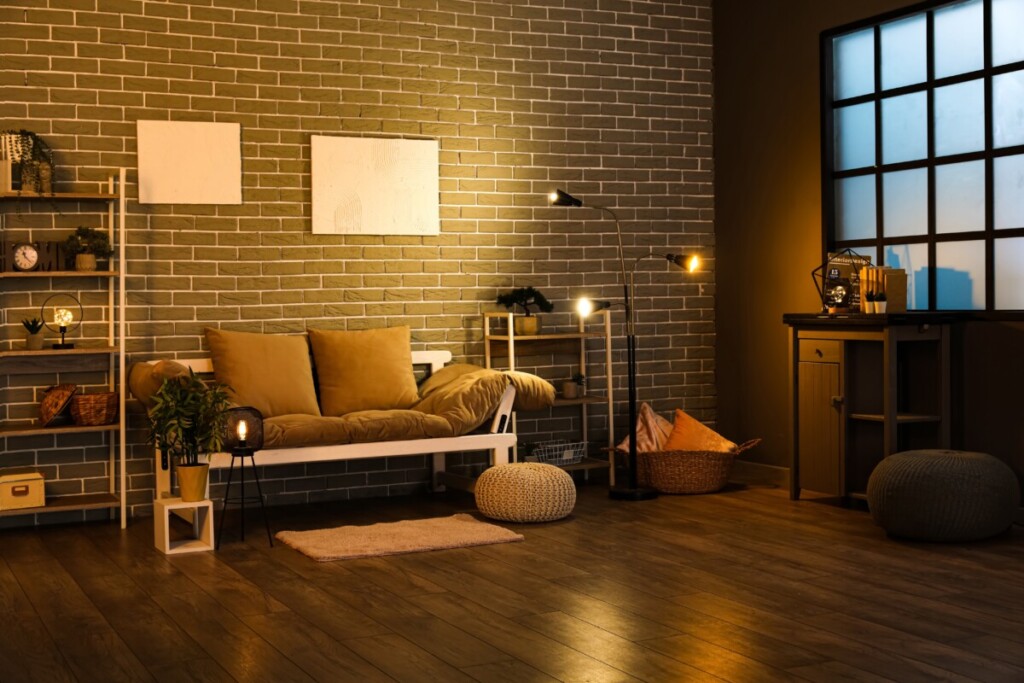26 Simple Ways to Create a Zen Meditation Space at Home That You’ll Actually Use


Whether you’re living in a bustling NYC apartment or settling into a new house in Austin, carving out space for stillness can bring a powerful shift to your day. A mindfulness or meditation corner doesn’t need to be grand—just intentional. From grounding scents to cozy throws, we asked mindfulness coaches, interior designers, and wellness professionals how they create calming spaces that invite you to pause. Here’s what they shared—practical, beautiful ideas that work in homes of every size.

1. Incorporate warm lighting and hidden storage
Sarah Samaan from Winding Road Yoga suggests, “Just a few minutes of mindfulness each day can ease stress and support overall well-being. Even a small corner of your home can become a calming space with intentional touches—like a folding screen for separation or a basket to store your mat and blanket. Add a warm dimmable light and a grounding object, such as a stone or diffuser, to make it feel personal. Let it be a space to come home to yourself.”
2. Use scent and soft light to eliminate distractions
Tiffany from Tiffany Egbert Studio, recommends, “To make meditation or mindfulness part of your daily routine, dedicate a small, cozy space in your home. Use a comfy chair, cushion, or yoga mat—whatever feels best for sitting or lying down. Add calming scents like lavender and use soft, dim lighting to create a peaceful mood. Choose a quiet spot, and keep a journal nearby to capture thoughts or ideas that arise during your practice.”
Quick Tip:
Laura Sag from CHILL Anywhere provides insights into what to while in your meditation space,
- “Pick the same spot daily—consistency builds habit.
- Keep it simple and clutter-free; less is more.
- Add a prop like a candle or diffuser if it helps you focus.
- Choose a private nook, even if it’s small or time-based.
- Comfort matters more than size—just feel good in the space.
- Use a quality cushion, mat, or seat for support.
- Minimize noise at first; quiet helps beginners stay focused.”
3. Invite deep relaxation with tea, texture, and your favorite candle
“Creating a peaceful space at home makes it easier to lean into practices that support inner calm,” mentions Keirst and April Rooted Renewal Wellness Retreats. “You don’t need much—just a few intentional touches like smart mood lighting, cozy blankets, a warm cup of tea, and your favorite scent or candle. These small details help activate your senses and invite deeper relaxation.”
4. Pick the right location to limit distractions
“Choose a calm corner of your home, away from busy areas and workspaces,” recommends Vivian Chen from Rise. “Whether you prefer natural light or a darker cocoon-like space, the key is minimizing distractions. Meditation is about slowing the senses—not cutting them off—so add relaxing sounds, essential oils, or anything that brings you peace.”
5. Engaging all five senses
“Creating a mindful space doesn’t have to be complicated—just focus on elements that soothe your senses,” says Lesley Goth, PsyD. from Denver Family Counseling Services. “Use scents, textures, sounds, and visuals that bring peace, like soft blankets in the living room or calming music in the kitchen. No matter the room or home size, designing with all five senses in mind helps foster a deeper sense of tranquility.”
6. Personalize your space with light, nature, and comfort
“All you need for a peaceful mindfulness corner is a quiet spot, ideally with natural light,” shares Serena Finocchio from Serene Yoga. “Add a pillow, yoga mat, and grounding elements like plants, crystals, or a small statue. Make it your own so the space feels calming and comfortable every time you return to it.”
7. Include the five Feng Shui elements in your meditation space
Anjeet Ratansi from Modern Feng Shui says, “A mindfulness corner should include the five Feng Shui elements—wood, water, fire, earth, and metal—to promote balance and positive energy flow. Each element brings its own energy; for example, wood symbolizes growth and prosperity, while water supports flow and calm. Water can be represented by mirrors, glass, or shades of blue and black. Decorating with these elements helps create harmony not just in your space, but in your life.”
“Feng Shui encourages having a dedicated space at home for relaxation and inspiration—whether it’s a cozy corner, balcony, study area, or bedroom chair,” says Ken, known as the Master Ken Koh. “The key is to make it naturally inviting using all five senses: a clean, clutter-free area with a light breeze (sense), soft lighting and meaningful decor (sight), calming sounds or a podcast (sound), soothing scents like potpourri or essential oils (smell), and cozy textures like a favorite blanket or throw (feel).”

8. Convert a closet into a quiet retreat away from chaos
“If your home is busy or full of little ones, a closet can be the perfect tucked-away spot for mindfulness,” suggests Meryl Arnett, Creator and Host of Our Mindful Nature podcast. “I turned a corner of mine into a meditation space with meaningful art, favorite quotes, a fuzzy rug, cushion, blanket, electric candles, and a Bluetooth speaker. It’s quiet, cozy, and deeply personal—proof you don’t need much space to create calm.”
9. Choose a low-traffic spot to encourage consistency
Billy Wynne from Mindfulness-Based Meditation Teaching & Coaching recommends, “Start by selecting a quiet, low-traffic area you can use regularly—ideally not in a hallway or main living space. A guest room, office, bedroom corner, or large closet can all work. Add a cushion or chair for seating, and if possible, choose a spot with natural light. Some like to include a small altar with meaningful items and use calming scents like essential oils or incense to enhance the space.”
10. Keep it simple with a candle, journal, and intention
Carmen Margaziotis, L.Ac. from Carmen Margaziotis says, “You don’t need anything fancy to create a mindfulness space—just the intention to slow down. I keep it simple: sit in bed, light a candle, and close my eyes. If my mind’s busy, I journal a few pages first to clear the noise. A cozy blanket or grounding scent like cedarwood helps, but the real power is in just showing up.”
11. Use soft light and plants to transform tiny spaces
“Even the tiniest space can become a mindfulness retreat when designed with care.” Claudia Mejia from Vibrancy Live Well insists, “We suggest soft lighting, a grounding cushion, calming scents like lavender or cedar, and plenty of natural plants to boost vitality. Add soothing soundscapes to engage the senses and encourage stillness. These small details create a space that nourishes both body and spirit.”
Quick Tip:
“When negative thoughts arise, use the phrase Be Mindful as a gentle cue to pause,” suggests John Shearer, Mindfulness Coach & Trauma Therapist. “Then, connect in three ways: to your surroundings through your five senses, to the people around you with full presence, and to your intuition or source of energy. This simple practice helps you reset and stay grounded, no matter what life throws your way.”
12. Use calming elements that reflect your happy place
“A mindfulness corner can fit into any home—just choose a spot where you feel at peace.” Yolanda Williams, Creator of The Energetic Alchemist Oracle continues, “If the beach brings you calm, use ocean-inspired elements like blue tones, shells, and a sound machine with waves. Add cozy textures, soft lighting, and a favorite book or photo to make the space personal and soothing. With a few thoughtful touches, you can create a corner that promotes clarity and relaxation.”
13. Turn small nooks into personalized sanctuaries with sensory details
Sally and Megan from ChildLight Yoga say, “We believe even the tiniest space can become a sanctuary with intentional design. Use soft lighting like a salt lamp, cozy seating, and grounding scents such as lavender or eucalyptus. Add gentle soundscapes to promote calm, and include a personal item or quote to remind you to pause and be present.
14. Try a soft-glow lamp and a diffuser with calming oils
“Creating a dedicated mindfulness corner at home is a powerful way to support your well-being,” mentions Jeanne, author and blogger known as Jeanne Nangle. “In mine, I use a soft-glow lamp for a peaceful vibe, a comfy cushion for journaling or breathing, and a diffuser with calming oils like bergamot or eucalyptus. The space helps me slow down and recharge in just a few quiet minutes.”
15. Fix these four Feng Shui mistakes draining your space
Jen Singer from The Feng Shui Agency recommends, “If you want to raise the energy in your home or office, start by addressing these Feng Shui disruptors:
- Water leaks drain your finances just like they drain your pipes.
- Dead or dying plants bring heavy, stagnant energy—like attracts like.
- Too much furniture blocks energy flow the same way it blocks movement.
- Cluttered corners trap stale energy and weigh down the space.
Even small changes here can instantly lift the vibe and energy of your entire space.”
16. Pick a supportive seat to improve posture and focus
Artem Zen, an artist, writer, and educator stresses that, “The most important part of any meditation space is a seat that supports comfort and good posture. Whether it’s a chair, cushion, or bench, it should help your spine stay naturally upright without strain. Prioritizing physical ease and alignment sets the stage for deeper stillness and focus.”
17. Add grounding elements from nature for deeper calm
Sagel Urlacher is the author of The Book of Yoga Nidra Meditation Scripts and Yin Yoga & Meditation, recommends, “A mindfulness space doesn’t need to be elaborate—just thoughtful. A floor cushion, soft throw, and candlelight can help calm the nervous system. Add earthy scents like sandalwood, natural textures, and one meaningful object to ground you. Gentle nature sounds like birdsong or ocean waves can further anchor the space in calm. Let it feel like a quiet exhale, inviting you back to yourself with each breath.”
18. Create your mindfulness corner near a window
Mindful Health shares, “I like to create my mindfulness corner near a window using warm neutrals and soft fabrics for a cozy vibe. A pop of color from fresh flowers or a plant, plus an amethyst crystal, helps set intentions and support intuition. I always keep a journal, Louise Hay affirmation cards, and a diffuser—lemongrass for day, lavender or rose for evening. Essential oil rollers are also nearby, ready to match my mood.”
19. Layer lighting, scent, and natural elements
“Creating a mindful space is about balance and intention. I use soft, dimmable lighting and natural elements like a potted plant or wooden table to bring calm and grounding energy,” suggests Jonas Muthoni. “Aromatherapy—lavender or eucalyptus in a diffuser or candle—helps settle the mind. Even the smallest space can become a peaceful sanctuary with these thoughtful touches.”
20. Visualize your dream space before designing it
“Creating your ideal mindfulness space starts with imagining how peace, joy, and calm feel to you.” Angela Wetzel from Epic Initiator continues, “Picture what surrounds you—textures, scents, and colors—then seek inspiration in movies, magazines, or even AI tools like DALL·E 3 or Midjourney to help bring that vision to life.”
21. Design a space that makes you want to return daily
Stephanie, Founder of LiveWellFlow, suggests , “Make your mindfulness space one you’re drawn to—a place that reflects rest and comfort. Include soft but supportive seating, a spot for your tea, a warm throw, and a journal or notepad within reach. Small touches like these create a space that feels both grounding and inviting.”
22. Prioritize comfort
Dreamwalkers Meditations’ Founder and Creative Director, Tyler Boyle, says, “Comfort is key when creating a meditation space—you don’t need to sit on the floor. Try a cozy accent chair that fits your style and experiment with lighting, from bright sunlight to complete darkness. Keep a sleep mask on hand to find what helps you settle. A journal nearby is also helpful for capturing post-meditation reflections.”
23. Incorporate items like journals or prayer beads
“A well-designed mindfulness space can support meditation, reflection, and mental wellness over time.” Sam Nabil, therapist, coach and marriage counselor from Naya Clinics adds, “Start with comfortable seating and natural or soft lighting to set a calming tone. Add nature-inspired decor, soothing scents like lavender or sandalwood, and ambient sounds or a sound bowl to create a peaceful atmosphere. Include mindfulness tools like journals or prayer beads, cozy blankets, and personal touches that inspire calm. Keep the space clutter-free, and manage tech use to avoid distractions and stay focused.”
24. Choose a few sensory objects to help you focus
Sensei Alex Kakuyo from The Same Old Zen suggests, “Mindfulness helps quiet intrusive thoughts by shifting our attention to the present moment. When creating a mindfulness corner, select 1–3 objects to focus on—like incense smoke drifting upward or the feel of a soft blanket against your skin. These sensory anchors guide awareness, and the possibilities are only limited by your creativity.”
25. Turn your entire home into a mindfulness oasis
“Instead of limiting mindfulness to one corner, let your whole home support your well-being,” shares Danijela from Unfolding Space. “Start by removing items that no longer reflect or energize you. Then ask: What would I change if my home truly supported mindfulness? Make those shifts—add grounding scents, calming sounds, and intentional touches. When your space reflects your essence, mindfulness becomes a natural part of daily life.”
26. Name your space to add meaning and intention
Gabrielle Thomas from Aerial Produced says , “Creating a comfy, quiet, and intentionally designed space for mindfulness is a powerful way to anchor your practice. Soft textures, calming scents, and warm lighting turn it into a true sensory retreat. But at The Aerial, BVI, we believe naming the space is what gives it deeper meaning and intention. Whether it’s The Clarity Corner, Peace Place, or Sanctuary of Wisdom, a name creates a mental shift the moment you enter—transforming it from a simple nook into a destination for presence, reflection, and grounding.”

Courtesy of Aerial Produced
The post 26 Simple Ways to Create a Zen Meditation Space at Home That You’ll Actually Use appeared first on Redfin | Real Estate Tips for Home Buying, Selling & More.







